| The Golden Years
John Marston's Eldest son, Charles, was in charge
at Villiers and rapidly expanded the highly profitable company. When
faced with a claim for death duties, after has father's death, he
sold John Marston Limited to a consortium of wartime munitions
manufacturers who had done well out of the war and were looking for
somewhere to invest their money. After John's death, Thomas Cureton,
who was John's right-hand man became chairman. Sadly he soon died,
and was replaced by Sidney Bowers. In 1919 the consortium was taken
over, and became part of Nobel Industries Limited, and a return to civilian
production was authorised by the Government. |
|
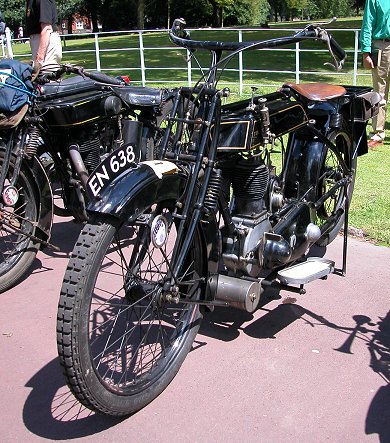
Richard Morris's 3.5 hp. Sunbeam from
1915. |
Sunbeam quickly produced a
new catalogue, which listed what were basically models from the 1916
range, and new versions of the W.D. machines. The catalogue included
the new 3½ hp. 'Sporting Model' which was nearly identical to the 'W.D.
3.5' and sold for 95 guineas.
There was also a 3½ hp. 'Standard'
model which sold for the same price. There was a new 8 hp. machine,
that was basically the 8 hp. JAP powered W.D. machine. It sold for
115 guineas with a sidecar. The 'Number 1' sidecar now sold for £27
guineas and the 'Number 2' sidecar sold for 35 guineas. These prices
soon increased due to the rapid inflation which followed the war.
Prices continued to increase
until 1921, when the 3½ hp.
models sold for 171 guineas. The new models were well received by
the general public. The press considered that they were amongst the
most handsome machines on the road and the 3½ hp. single was described as the Rolls Royce of
singles. |
|
When motorcycle sporting events
restarted in 1919, Sunbeam continued to have a high profile and
be very successful. Competitions were dominated by Sunbeam riders
such as George Dance, Tommy de la Hay and John Greenwood.
A new
Sunbeam range was developed in readiness for 1920. The new machines
included the famous laminated leaf spring front fork, which was to
be an important feature of future Sunbeam machines.
Larger cylinder cooling fins were introduced
along with drum brakes on the 3½ hp.
model. Another introduction was detachable and interchangeable
wheels.
1920 was to be an important year for the Sunbeam competition
team. The company achieved its first T.T. victory when Tommy de la
Hay came first in the Senior Race at an average speed of 51.79 m.p.h.
W.R. Brown came third on a similar machine and George Dance had the
fastest lap at nearly 56 m.p.h. |
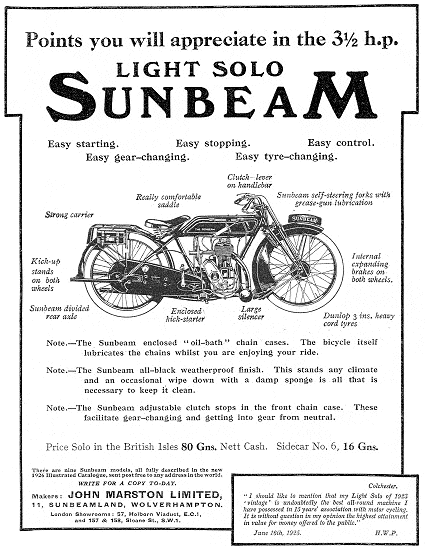
An advert from February 1920. |
|
An article from 'The Motor Cycle',
1st April, 1920.
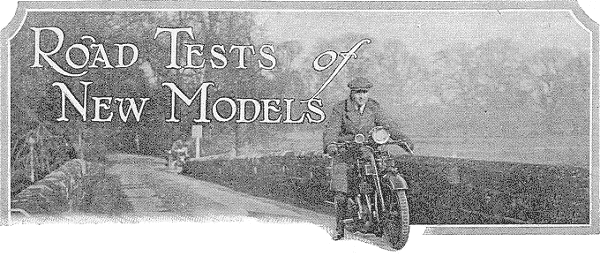
Impressions
of a High-class Solo Mount – the 3½ hp. Sunbeam – which
has already won its Spurs in
Competition.
A machine which has always occupied
a place in the very front rank is the Sunbeam. With the
happiest memories 'of a Six Days Trials' experience in
the Lake District on a 2¾ hp. model, it was with the
greatest pleasure that the writer adopted Mr. A. S.
Bowers' suggestion of an extended trial of the 1920 3½
hp. single-cylinder sporting model. By reason of its
good name, one, of course, expects a great deal from a
modern mount with the now familiar black and gold tank,
but those expectations are fulfilled in their entirety
-nay, more-on acquaintance with the machine.
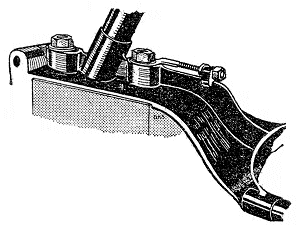
The 'T' section bottom bracket casting
now employed. The front chain adjustment is
effected by a draw bolt. |
First impressions are everything, they
say. Our trials machine was handed over
tuned to the last notch and equipped to the
last word. Would that we could say the same
of every machine placed at our disposal for
trial!
A dig at the kick-starter, and the
willing engine promptly answered, the
silky-acting clutch engaged, and away the
machine went as smoothly as a good-class
car. Gear changing proved easy, and, in
short, one was at once inspired by the
feeling that the machine was in perfect tune
and condition, and ready for the most
difficult test. |
There is a great deal of difference
in the controllability of modern motor cycles. Some
engines are docile and tick over quietly in the free
position; others with smaller flywheels and less
carefully designed cams will roar and vary in their
actions when not running under load. Need we say that
the Sunbeam belongs to the former category? It is by
no means a lightweight, yet its controllability, due to
its well-balanced engine and conveniently arranged
controlling mechanism, contributes in no small measure
to the contentment of the rider and feeling of long
acquaintanceship with the machine, even though that
acquaintance may have been but short.
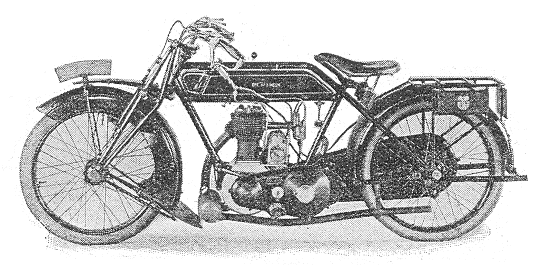
The latest 3½ hp.
sporting model Sunbeam which has a laminated type spring
fork.
With semi T. T. bars and the new
type laminated spring fork, one can imagine no more
desirable type of mount for the man who desires to "get
there" and back, and with the minimum loss of time. Hill
climbing with this all chain-driven "3½" with its 85 x
88 m.m. (499 c.c.) side valve engine, is a sheer
delight. Although provided with three separate ratios,
the lower ones are seldom called into use for solo work,
except, of course, when starting away from rest, and
possibly in thick traffic, for all ordinary hills are
quite within the compass of the top gear of 4.6 to 1
even with a rider of 11½ stone up. It is no compliment
to a mount of the Sunbeam calibre to instance Sunrising
Edge, and Sudeley Hills, since public trials have
demonstrated that no hill with a rideable surface is too
steep for such a mount.
| One's appreciation must
therefore be devoted to its reliability, its
cleanliness, its controllability, and its
generally excellent design, leaving hill
ability as a foregone conclusion. We have
proved that the clutch will stand any amount
of abuse. The handiness of the detachable
wheels we have not had occasion to
demonstrate with this latest 3½ hp., since
the makers are wise enough to equip it with
tyres well up to their work, and which, as
an almost natural result, have, never
punctured.
A detail worthy of praise is the oil feed
to the gear box, controllable by a two-way
tap operated from the saddle, thus
eliminating the need for periodic use of the
usual separate, oil gun, which, to say the
least, is a nuisance and a messy operation
at best. The gears, incidentally, are
extremely quiet in action, as well-cut gears
usually are. |
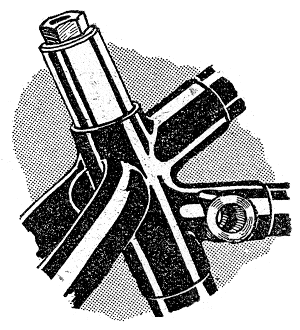
The seat lug of the 3½
hp. Sunbeam has rear stays brazed-in. An
expander bolt and cone secures the
saddle-pillar. |
A Cool Running Engine.
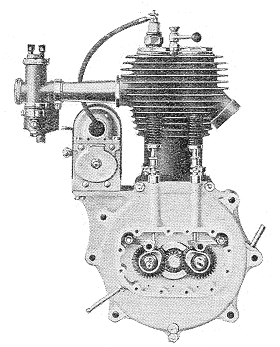
The power unit of the single-cylinder
Sunbeam, which has a capacity of 499 c.c. |
Prolonged fast running in no way affects
this remarkably efficient engine, and that
the cooling is sufficient for all purposes
is demonstrated by the ease with which
single figure gradients are surmounted on
the run.
Indeed, as we have said, the Sunbeam
owner can revel in hill work whether the
roads are wet or dry, for in the event of
wet, the rider can proceed in comfort so far
as the machine is concerned, buoyed up with
the knowledge that, whatever the elements,
the transmission, running as it does in oil
bath chain cases, is working under ideal
conditions.
The prolonged life of chains, due to
their entire protection from outside
elements, needs no emphasis. In our trials
we have been impressed by the absence of
valve clatter; separate timing wheels are
employed for inlet and exhaust with their
respective cams formed upon them, the cams
operating the adjustable headed tappets
through rockers. |
Once or twice in a rather tight
corner, we have raised the left handlebar lever
expecting to operate the valve lifter, forgetting for
the moment that the control of the Sunbeam front brake
is operated by the left-hand lever and the valve lifter
on the right; but that, after all, is due to custom, and
only confirms our opinion that motor cycle controls,
should be standardised.
| The exterior and interior of the
Sunbeam countershaft three-speed gearbox, a
design in which the gears are always in
mesh.
The operating mechanism, as well as
the kick starter, crank and its pinion, are
plainly discernible. |
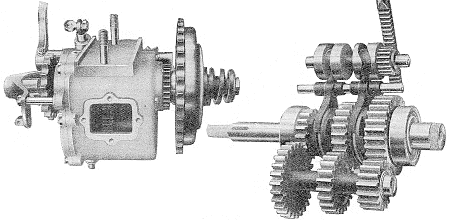 |
The brakes themselves
are extremely effective and solidly arranged, nothing to
get bent or disappear with vibration, the wide guards
are a feature to admire, whilst throughout the design
bears the mark of the master hand only to be expected
when one realises that managers, designer, and testers
alike are keen motorcyclists themselves, always out to
improve, and having a high standard invariably in mind.
In brief, our experience of the machine, extending over
several weeks, has been entirely devoid of untoward
incident, it has failed at nothing, started easily with
wonderful consistency, not even a puncture has marred
our enjoyment, and consequently one may justly dub the
Sunbeam as a machine of unfailing reliability. |
|
|
The 1921 catalogue included
three versions of the 3½ hp. model, the 'Standard', the
'Semi-Sporting', and the 'Sporting Solo Sunbeam T.T. Model'. Prices
reached their highest ever. The 8 hp. machine sold for 176 guineas
and the 'Number 2' sidecar cost an extra 50 guineas. Prices soon
began to fall however, as ex W.D. machines became available to the general
public. This caused a lot of problems in the industry as many
manufacturers now suffered from over production, because the
motorcycle buying public were snapping up these ex W.D. bargains in
preference to new models. The price of the 8 hp. machine soon fell to
160 guineas and the sidecar fell to 47 guineas.
In 1921, George Dance made a
series of superb runs at Brooklands. In the 350 c.c. class he set a
new record at 82.25 m.p.h. in the Flying Kilometer, and achieved
82.19 m.p.h. in the Flying Mile. In the 500 c.c. class he achieved
93.99 m.p.h. in the Flying Kilometer, 87.35 m.p.h. in the Flying 5
Miles and 82.69 m.p.h. in the Standing 10 miles.
Two new models were introduced in 1922. The
'Longstroke T.T.' 3½ hp.
machine made its appearance , as did the 4¼ hp. Sunbeam, which was mainly sold
with a sidecar. |
| Sunbeam achieved its second T.T. win in the
Senior Race when Alec Bennett came in first, at an average speed of
58.33 m.p.h. Back in Wolverhampton this
caused big problems, because the win led to a disagreement between
Alec Bennett and Tommy de la Hay. They each wanted to be regarded as
the leading Sunbeam rider.
Sidney Bowers intervened and chose Tommy,
and so Alec Bennett left Sunbeam to work for Douglas. He didn't ride
for Sunbeam again until 1929. |
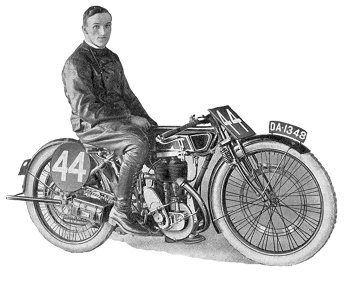
Alec Bennett. |
| In 1924 the 8 h.p. twin was discontinued, and a new model
numbering system introduced: |
| Model 1. |
2¾ hp. with full road equipment |
| Model 2. |
2¾ hp. with less equipment |
| Model 3. |
The old ‘Standard’ 3½ hp. model |
| Model 4. |
The old 3½ hp. now
fitted with a 4¼ hp. engine |
| Model 5. |
The old 3½ hp. ‘Solo’ |
| Model 6. |
The old ‘Longstroke’ |
| Model 7. |
A 4-speed version of the 4¼ hp. machine |
| Model 8. |
‘Standard’ 350 c.c. o.h.v. machine |
| Model 9. |
‘Standard’ 500 c.c. o.h.v. machine |
| Model 10. |
350 c.c. ‘Sprint’ o.h.v. machine |
| Model 11. |
500 c.c. ‘Sprint’ o.h.v. machine |
|
An article from ‘The Motor Cycle’,
31st January, 1924.
Two New Sunbeam Models
Newly designed
frame, modified cylinder head, and mechanical
lubrication form features of the o.h.v. machines.
Much interest will centre around
the latest products of the Sunbeam factory. Two new
o.h.v. machines make their appearance, similar in engine
design but of different capacities, i.e., 347 c.c. and
493 c.c.
|
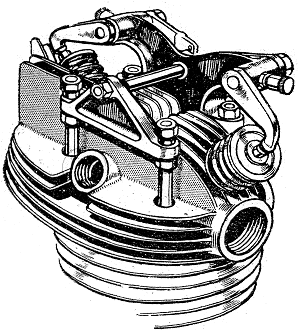
O.h.v. rocker details and cylinder head. |
In the first place, an entirely new
frame has been evolved, giving a wheel base
of 54 inches, which is of conventional
appearance, having a sloping top rail.
The front down tube ends in a tee piece
just below the tank, from which two members
are carried to the front engine plates.
To facilitate the removal of the cylinder
head the tube carrying the tank is made
detachable, and a few moments only are
required to effect its removal with the
tank.
A very careful piece of design, the
engine, is fitted with two overhead valves
operated by push-rods and rockers and
inclined in the semi-spherical cylinder head
at a steep angle. There are three springs to
each valve, and the rockers, which are
supplied with greasers, are equipped with
return springs. |
The cylinder head itself is
substantially constructed, special attention having been
paid to the finning, especially around the exhaust port.
Fitted at an angle at the left-hand side of the head,
the sparking plug is in the direct path of air currents.
The full skirted aluminium piston has three rings at the
top, while the gudgeon pin is of the full floating type.
In the larger engine the bore and stroke are 80 mm. x 98
mm. respectively, giving a capacity of 493 c.c.
|
Lubrication is carried
out by a mechanical pump which is of the
double gear type. It is mounted on the
outside of the timing gear cover.
Neatness is one of its
chief features, and its simplicity and the
scarcity of its working parts, coupled with
their positive operation, are assurances of
its reliability. There is a sight feed on
the tank.
A roller bearing is
provided in the big end of the connecting
rod, the main shaft being supported on ball
bearings.
Gas is supplied through a two-lever Amac
carburettor, and the spark is obtained from
it special E.I.C. magneto. |
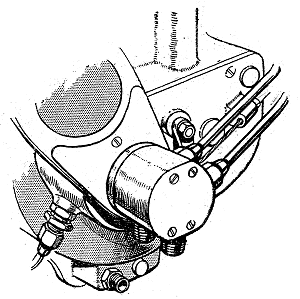
Mechanical oil pump on the new engines. |
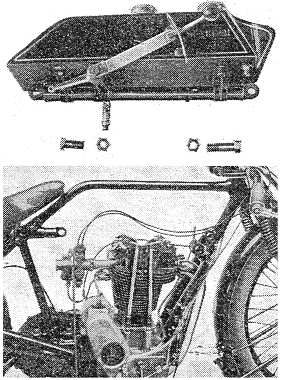 |
By removing two bolts, the tank and
top rail of the frame are quickly detached,
thus facilitating access to the cylinder
head. |
Transmission is by chain
throughout, the front chain being totally enclosed in an
oil bath case. On the larger machine the gears provided
give ratios of 4.4 to 1, 6 to 1, and 8 to l. The wheels
are shod with 26 in. x 2½ in. tyres, and
internal-expanding brakes are fitted fore and aft.
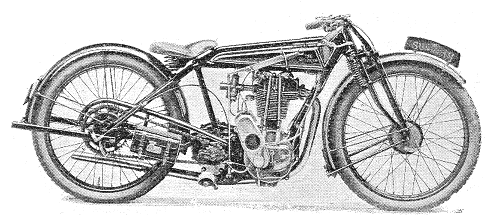
493 c.c. machine in the new sloping top tube frame,
available for both models.
The lower powered machine has an
exactly similar specification to the above, but the
engine has a bore and stroke of 70 mm. x 90 mm. =347
c.c., and the gear ratios are 4.9 to 1, 6.3 to 1, and 9
to l. Another item of interest is that in both sizes the
machines may be obtained with either the sloping top
tube frame or the more usual Sunbeam design.
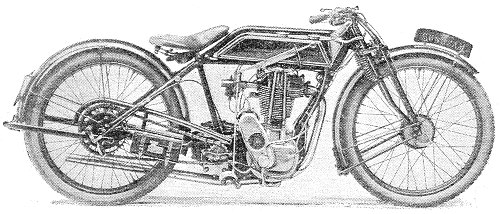
347 c.c. Sports Sunbeam with the new detachable tank
rail frame.
These extremely attractive machines
are priced at £105, with the larger power unit, and
£94.10s. with the smaller engine. |
|
|
In the 1920's sprint
meetings were a very popular form of motorcycle sport. They were
often held on a public road that had been closed especially for the
event. George Dance made quite a name for himself in the post 1918
years, with sprint and hill climb machines that were based on
standard 350 c.c. and 500 c.c. Sunbeams, with cut-down frames. He was
virtually unbeatable, and as Development Engineer at the works, the
famous 'Sprint' models were his creation. In 1925 the Government
banned racing on public roads; the last meeting took place at
Hereford on 4th April 1925.
The 'Sprint models were
discontinued, and in 1926 prices fell by about 5 guineas per model.
The cheapest machine then sold for £72, and the top of the range 'Model 9'
sold for £105. |
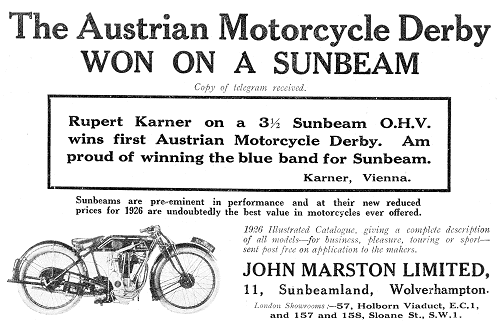
An advert from 1925.
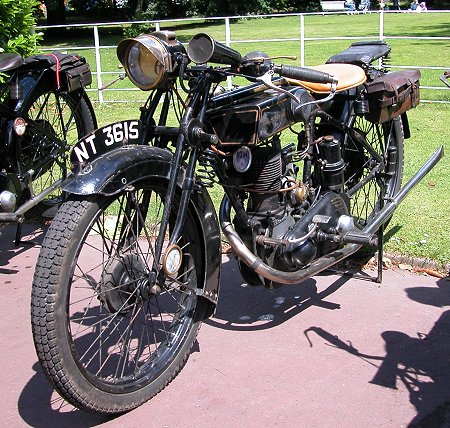
Bob Terry's Model 6 from 1927.

An advert from 1927.

|
|

|
|

|
| Return to The War
Years |
|
Return to the
beginning |
|
Proceed to Decline
and Fall |
|